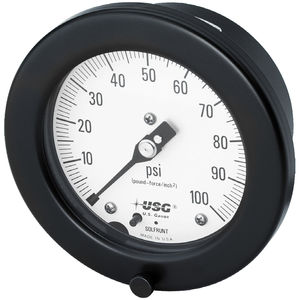
Absolute pressure gauge SOLFRUNT® 1933analogpanel-mountflange



Add to favorites
Compare this product
Characteristics
- Pressure type
- absolute
- Display
- analog
- Mounting
- panel-mount, flange, back mount
- Material
- stainless steel, aluminum, steel
- Technology
- Bourdon tube
- Protection level
- corrosion-resistant
- Applications
- process, for vacuum
- Other characteristics
- adjustable
- Pressure
Max.: 6,000 psi
Min.: 0 psi
- Precision
0.5 %
- Dial diameter
4.5 in
Description
The SOLFRUNT 1933 process gauge has 316L SST wetted parts, and comes in a gauge size of 4 ½", used for applications needing panel mounting. The Model 1933 process gauges have a cast aluminum solid front flange case for maximum operator safety with a lower-back mount ¼” or ½” NPT process connection.
Model 1933 pressure gauge is supplied in many different ranges including vacuum, compound, and pressure ranges from 30" Hg vacuum through 11 600 psi. Dials are available in psi gauge or metric versions.
Ranges: Vacuum - 30 to 0 "Hg VAC (counterclockwise rotation)
Compound - 30"Hg VAC to 100 psi
WINDOW: High temperature acrylic, laminated shatter-resistant glass options available
MOVEMENT: Geared ARC-LOC with components of corrosion-resistant 300 series stainless steel. Movement can be removed for examination and cleaning without disturbing span and scale shape adjustments
DIAL: Aluminum with baked white background and black markings
POINTER: Anodized aluminum, micro-adjustable with black finish (optional lazy hand available, part number 074963, with dry gauges only)
CASE AND RING:For Panel Mounting:Cast aluminum, front-flanged case with steel hinged ring, black finish and pressure-relieving back
Catalogs
No catalogs are available for this product.
See all of AMETEK PMT Products‘s catalogsRelated Searches
- Measuring device
- Pressure transmitter
- AMETEK pressure gauge
- Level probe
- Liquid level probe
- Analog pressure transmitter
- AMETEK analog pressure gauge
- Membrane pressure transmitter
- Relative pressure transmitter
- Stainless steel pressure transmitter
- Analog level probe
- AMETEK threaded pressure gauge
- AMETEK level transmitter
- AMETEK stainless steel pressure gauge
- AMETEK liquid level transmitter
- AMETEK Bourdon tube pressure gauge
- AMETEK dial pressure gauge
- Absolute pressure transmitter
- Gas pressure transmitter
- AMETEK process pressure gauge
*Prices are pre-tax. They exclude delivery charges and customs duties and do not include additional charges for installation or activation options. Prices are indicative only and may vary by country, with changes to the cost of raw materials and exchange rates.









